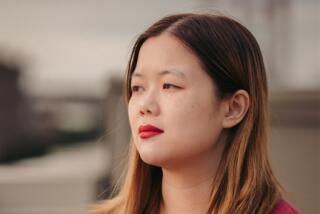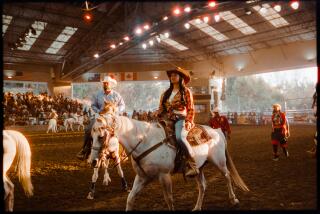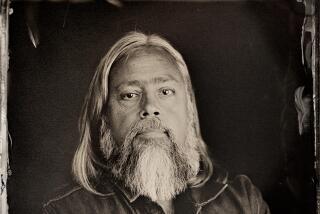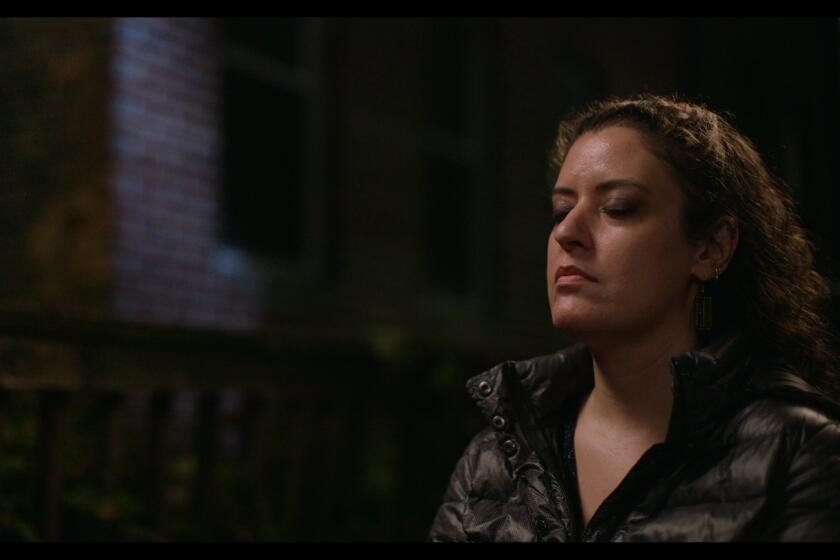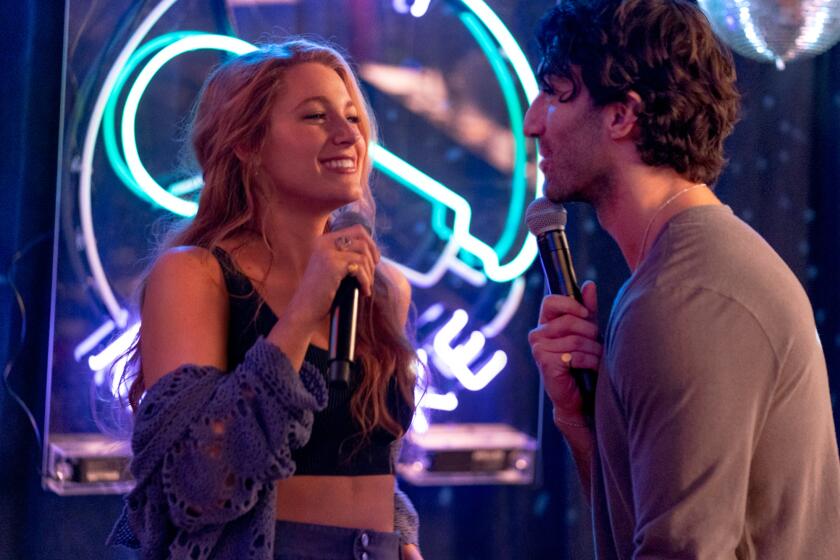Review: Chloé Zhao’s cowboy drama ‘The Rider’ is a moving, lyrical tale of loss and recovery

“The Rider” is an achingly beautiful contemporary western and a fascinating blend of narrative and documentary film techniques, set among the Lakota cowboys of South Dakota’s Pine Ridge Indian Reservation.
There are moments in “The Rider,” Chloé Zhao’s achingly beautiful heartland elegy, when we see Brady Jandreau, a Lakota cowboy in his early 20s, simply doing what he was born to do. (Quite literally: Jandreau was just 15 days old when he sat on his first horse.) Tenderly and patiently, the camera watches as he trains a horse in a small enclosure, uttering words and performing gestures that have clearly become second nature. He even prays for one of them, caressing its coat and speaking a blessing in Jesus’ name.
For most of the people we meet in “The Rider,” set on South Dakota’s Pine Ridge Indian Reservation, God is as real, enveloping and matter-of-fact a presence as the rugged landscape they call home. But Zhao’s restrained, unsentimental style is the opposite of preachy, which makes it all too easy to underappreciate the sublimity of her achievement. With its gorgeous frontier lyricism and its wrenchingly intimate story of a young man striving to fulfill what he considers his God-given purpose, “The Rider” comes as close to a spiritual experience as anything I’ve encountered in a movie theater this year.
From a simple story of personal struggle, Zhao coaxes forth a stirring ode to a little-seen, hard-scrabble way of life and a sobering portrait of masculinity in crisis. But her movie is also a full-fledged contemporary western, a hymn to the beauty of wide-open plains, majestic sunsets and strapping young men on horseback. (The cinematography is by Joshua James Richard, who shot the equally ravishing “God’s Own Country”; Nathan Halpern wrote the plaintively lovely score.)
Zhao, a Chinese-born, U.S.-based independent filmmaker, isn’t interested in drowning the myth of the American cowboy in layers of Hollywood gloss; she strips it down to its raw materials and ponders its contradictions. She steers us into a world of wind-beaten badlands and rundown trailer homes, where young Lakota men wear chaps and Stetsons and harbor dreams of rodeo stardom. On this particular frontier, cowboys and Indians are one and the same.
Jandreau was one of several Lakota cowboys Zhao met while shooting her low-budget debut feature, “Songs My Brothers Taught Me” (2015). The lovely, meandering synthesis of fiction and nonfiction techniques she achieved in that movie has advanced here to new levels of artistic refinement, not least because her formal explorations have been tethered to a uniquely harrowing real-life story.

“The Rider” is an achingly beautiful contemporary western and a fascinating blend of narrative and documentary film techniques, set among the Lakota cowboys of South Dakota’s Pine Ridge Indian Reservation.
In April 2016, Jandreau, a bronco rider and local rodeo star, saw his dreams crushed when he fell off his horse and suffered a serious skull injury. He returned home with a steel plate in his head, a gash down his scalp and a doctor’s warning that his riding days were over.
Shortly afterward, Zhao began filming him and his friends and family, gradually piecing together the lightly fictionalized story of one Brady Blackburn and his difficult physical and emotional recovery. The result is a seamless, collaborative weave of documentary and narrative filmmaking in which every scene, even when heightened for dramatic effect, has a bone-deep authenticity.
One of the movie’s more understated insights concerns the mysterious kinship between humans and horses — not just their natural affinity for each other, but also their occasional similarities of temperament. Brady, as stubborn as any of his four-legged charges, has no intention of listening to his doctors and abandoning his rodeo dreams.
Rather than resting up as he’s been ordered, he spends as much time as possible with his own horse, Gus. He tirelessly trains other horses in the community, a task made more difficult by the complex partial seizures he periodically experiences, which cause his right hand to stiffen uncontrollably. He’s not foolhardy enough to jump immediately back into the saddle, but he assures everyone he meets that his absence from the rodeo will be strictly temporary.
Those closest to him, many played by their real-life counterparts, are not so easily fooled. Brady is able to lower his guard around his 15-year-old sister, Lilly (Lilly Jandreau), who steers him through his recovery with songs, encouragement and lively chatter. Lilly has Asperger’s syndrome, and the siblings’ warm sense of mutual protectiveness is one of the movie’s most consoling pleasures.
Brady also visits one of his best friends, Lane Scott, a former bull rider who was left paralyzed and unable to speak after an accident, but who remains a spirited optimist and encourages his pal to cling fiercely to his dreams. (In real life, Scott sustained his injuries in a 2013 car crash, but the movie is ambiguous on the matter.) Zhao approaches these scenes with remarkable delicacy, never reducing her actors to their disabilities or milking them for easy pity.
Brady has a tougher relationship with his hard-drinking, heavy-gambling father, Wayne Blackburn (Tim Jandreau), who regards his son with a complicated mix of superiority, disappointment and clumsy, infrequent affection. You could read an entire history of male generational angst into the tense, competitive exchanges between father and son, neither of whom can be said to be merely playing themselves here; Tim Jandreau, in particular, incarnates the wily movie-star charisma of a young Beau Bridges.
It’s a gift that he has passed on to his more soft-spoken son, who both fits the handsome, laconic cowboy mold and breaks triumphantly free of it. Brady Jandreau is an extraordinarily magnetic camera subject. This may be his story, but enduring it and evoking it are two very different challenges; few professionally trained actors could achieve the emotional eloquence that he manages in a single downward glance. Is Jandreau acting, or merely being? I’d suggest a third option somewhere in between, in that mysterious realm where art resides.
Brady tries to move on, getting a job at a supermarket and almost pawning his beloved saddle. But he can’t escape the words of encouragement — easy to say, difficult to hear — from everyone around him, whether it’s an admiring young fan or the longtime friends he gathers with around a campfire for a night of booze, trash talk and guitar music. “You ride through the pain,” a buddy reminds him, needlessly. As if pain were even the issue.
What do you do when the only dream you’ve ever known has been cruelly ripped away? When the one thing that gives your life purpose now threatens that life’s survival? Zhao wisely avoids offering easy answers to those questions. Her picture captures the exhilarating sense of liberation that rodeo riders must feel, if only for eight seconds at a time. But it also conveys the limited options available to those reared in this fragile but fiercely guarded community, whose traditions have long been codified into ritual. There are times when these endless prairies feel downright claustrophobic.
In the most literal sense, “The Rider” may be a movie about trying to get back on that horse, but there may well be a subtler, truer metaphor at work. Again and again, we see Brady using his left hand to assist his right one, repeatedly prying open his clenched, gnarled fingers one by one. It’s a quietly heartbreaking image of human struggle, of the limitations of the body and also the compensations of the spirit. Releasing one’s grip, this movie knows down to its bones, can be as painful as it is necessary.
------------
‘The Rider’
Rating: R, for language and drug use
Running time: 1 hour, 45 minutes
Playing: The Landmark, West Los Angeles
Movie Trailers
justin.chang@latimes.com | Twitter: @JustinCChang
More to Read
Only good movies
Get the Indie Focus newsletter, Mark Olsen's weekly guide to the world of cinema.
You may occasionally receive promotional content from the Los Angeles Times.
